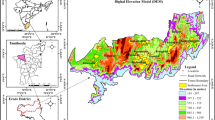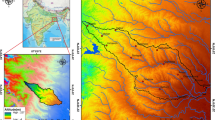Abstract
In a spatio-temporal scale, changing conditions of forest land cover and its detection study is an important concern for sustainable forest management. Nowadays, the forest canopy density (FCD) model has been used for the analysis and management of forest resources through identifying the forest gap areas where afforestation should be started immediately. The present study applied FCD model to detect changes in forest land cover in Sali River basin between the years 2000 and 2018. Moreover, the vegetation indices like Bareness Index (BI), Greenness Vegetation Index (GVI), Normalized Difference Vegetation Index (NDVI), Perpendicular Vegetation Index (PVI), and Shadow Index (SI) along with weighted overlay analysis have been used to prepare FCD map of the Sali river basin. It has been noticed from FCD map that south and north-eastern part of the study area covered with high canopy density in comparison with north and north-western region in the year 2000. Whereas, in the year of 2018, high FCD has been found in the middle portion of the southern region and the rest of the area varies from low to medium FCD.
Access this chapter
Tax calculation will be finalised at checkout
Purchases are for personal use only
Similar content being viewed by others
References
Andersen HE, McGaughey RJ, Reutebuch SE (2005) Estimating forest canopy fuel parameters using LIDAR data. Remote Sens Environ 94(4):441–449
Avtar R, Herath S, Saito O, Gera W, Singh G, Mishra B (2014) Application of remote sensing techniques toward the role of traditional water bodies with respect to vegetation conditions. Environ Dev Sustain 16(5):995–1011
Azizi Z, Najafi A, Sohrabi H (2008) Forest canopy density estimating, using satellite images. In: The international archives of the photogrammetry, remote sensing and spatial information sciences, vol XXXVII. Part B8. Beijing
Baynes J (2004) Assessing forest canopy density in a highly variable landscape using Landsat data and FCD mapper software. Aust For 67:247–253
Blodgett C, Jakubauskas M, Price K, Martinko E (2000) Remote sensing-based geostatistical modelling of forest canopy structure. Annual Proceeding of ASPRS, Washington, DC, pp 22–26
Boyd DS, Foody GM, Ripple WJ (2002) Evaluation of approaches for forest cover estimation in the Pacific North West, USA using remote sensing. Appl Geogr 22:375–392
Chakrabortty R, Pal SC, Malik S, Das B (2018) Modeling and mapping of groundwater potentiality zones using AHP and GIS technique: a case study of Raniganj Block, Paschim Bardhaman, West Bengal. Model Earth Syst Environ 4(3):1085–1110
Chowdhuri I, Pal SC, Chakrabortty R (2020) Flood susceptibility mapping by ensemble evidential belief function and binomial logistic regression model on river basin of eastern India. Adv Space Res 65(5):1466–1489
Cross AM, Settle JJ, Drake NA, Paivinen RTM (1991) Sub-pixel measurement of tropical forest covers using AVHRR data. Int J Remote Sens 12(5):37–41
CWC and NRSC (2014) Watershed Atlas of India. Ministry of Water Resource, New Delhi
Das B, Pal SC, Malik S, Chakrabortty R (2019) Modeling groundwater potential zones of Puruliya district, West Bengal, India using remote sensing and GIS techniques. Geol Ecol Landsc 3(3):223–237
Deka J, Tripathi OP, Khan ML (2013) Implementation of forest canopy density model to monitor tropical deforestation. J Indian Soc Remote Sens 41:469–475
FAO (2010) Global forest resources assessment 2010: Food and Agriculture Organization of the United Nations, Rome
FAO (2014) Global forest land-use change 1990–2010. Food and Agricultural Organization of the United Nations with the E.U. Joint Research Centre (JRC). Rome
FAO (2015) Global forest resources assessment 2015. FAO Forestry Paper No. 1. The Food and Agricultural Organization of the United Nations, Rome
Geological Survey of India (2003) https://www.gsi.gov.in/webcenter/portal/OCBIS/page1478/page1872?_adf.ctrl-state=10i7wmzvd45&_afrLoop=1920464058426572#!
Haila Y (1999) Islands and fragments. In: Hunter ML (ed) Maintaining biodiversity in forest ecosystems. Cambridge University Press, UK, pp 234–264
Halliday J, Tate K, McMurtrie RE, Scott NC (2003) Mechanisms for changes in soil carbon storage with pasture to Pinusradiata land-use change. Glob Change Biol 4:1294–1308
Howard JA (1991) Remote sensing of forest resources, theory and application. Campbell and Hall, London
Huete AR, Liu H, van Leeuwen WJ (1997) The use of vegetation indices in forested regions: issues of linearity and saturation. In: Geoscience and remote sensing, 1997. IGARSS’97. Remote sensing—a scientific vision for sustainable development, 1997 IEEE international, vol 4, pp 1966–1968. IEEE
Jennings S, Brown N, Sheil D (1999) Assessing forest canopies and understory illumination: canopy closure, canopy cover and other measures. Forestry 72:59–73
Joshi PKK, Roy PS, Singh S, Agrawal S, Yadav D (2006) Vegetation cover mapping in India using multi-temporal IRS Wide Field Sensor (WiFS) data. Remote Sens Environ 103(2):190–202
Kauth RJ, Thomas GS (1976) The tasselled cap–a graphic description of the spectral-temporal development of agricultural crops as seen by Landsat. In: LARS symposia, p 159
Lee AC, Lucas RM (2007) A LiDAR-derived canopy density model for tree stem and crown mapping in Australian forests. Remote Sens Environ 111:493–518
Liu W, Yamazaki F (2012) Object-based shadow extraction and correction of high-resolution optical satellite images. IEEE J Sel Top Appl Earth Observ Remote Sens 5(4):1296–1302
Malik S, Pal SC, Das B, Chakrabortty R (2019a) Assessment of vegetation status of Sali River basin, a tributary of Damodar River in Bankura District, West Bengal, using satellite data. Environ Dev Sustain 1–35
Malik S, Pal SC, Das B, Chakrabortty R (2019b) Intra-annual variations of vegetation status in a sub-tropical deciduous forest-dominated area using geospatial approach: a case study of Sali watershed, Bankura, West Bengal, India. Geol Ecol Landsc 1–12
Mensah S, Veldtman R, Seifert T (2017) Allometric models for height and aboveground biomass of dominant tree species in South African Mistbelt forests. Southern For J For Sci 79(1):19–30
Mon MS, Mizoue N, Htun NZ, Kajisa T, Yoshida S (2012) Estimating forest canopy density of tropical mixed deciduous vegetation using Landsat data: a comparison of three classification approaches. Int J Remote Sens 33(4):1042–1057
Morrow V, Young J, Roberts C (2001) Mapping tree canopy in Broward County, Florida
Nandy S, Joshi PK, Das KK (2003) Forest canopy density stratification using biophysical modeling. J Indian Soc Remote Sens 31:291–297
O’Malley LS (1908) Bengal District Gazetteers, Bankura. Government of West Bengal, India
Ono A, Kajiwara K, Honda Y (2010) Development of new vegetation indexes, shadow index (SI) and water stress trend (WST). Int Arch Photogramm Remote Sens Spatial Inf Sci 38:710–714
Pal CS, Chakrabortty R, Malik S, Das B (2018) Application of forest canopy density model for forest cover mapping using LISS-IV satellite data: a case study of Saliwatershed, West Bengal. Model Earth Syst Environ 4:853–865
Pal SC, Chowdhuri I (2019) GIS-based spatial prediction of landslide susceptibility using frequency ratio model of Lachung River basin, North Sikkim, India. SN Appl Sci 1(5):416
Pal SC, Das B, Malik S (2019) Potential landslide vulnerability zonation using integrated analytic hierarchy process and GIS technique of Upper Rangit catchment area, West Sikkim, India. J Indian Soc Remote Sens 47(10):1643–1655
Prasad PRC, Nagabhatla N, Reddy CS, Gupta S, Rajan KS, Raza SH, Dutt CBS (2009) Assessing forest canopy closure in a geospatial medium to address management concerns for tropical islands-Southeast Asia. Environ Monit Assess 160:541
Raha AK (2014) Time series analysis of forest and tree cover of West Bengal from 1988 to 2010, using RS/GIS, for monitoring afforestation programmes. J Ecol Photon 108:255–265
Richardson AJ, Wiegand CL (1977) Distinguishing vegetation from soil background information. Photogramm Eng Remote Sens 43(12):1541–1552
Rikimaru A (1996) Landsat TM data processing guide for forest canopy density mapping and monitoring model. ITTO workshop on utilization of remote sensing in site assessment and planning for rehabilitation of logged-over forests, Bangkok, 30 July–1 Aug 1996, pp 1–8
Rikimaru A, Roy PS, Miyatake S (2002) Tropical forest cover density mapping. Trop Ecol 43(1):39–47
Rouse J Jr, Haas RH, Schell JA, Deering DW (1974) Monitoring vegetation systems in the Great Plains with ERTS, pp 309–317
Roy PS, Sharma KP, Jain A (1996) Stratification of density in the dry deciduous forest using satellite remote sensing digital data—an approach based on spectral indices. J Biosci 21(5):723–734
Saaty TL (1988) What is the analytic hierarchy process? In: Mathematical models for decision support. Springer, Berlin, pp 109–121
Sahana M, Sajjad H, Ahmed R (2015) Assessing spatio-temporal health of forest cover using forest canopy density model and forest fragmentation approach in Sundarban reserve forest, India. Model Earth Syst Environ 1–10
Telesca L, Lasaponara R, Lanorte A (2008) Intra-annual dynamical persistent mechanisms in Mediterranean ecosystems revealed SPOT-VEGETATION time series. Ecol Complex 5(2):151–156
Verbesselt J, Jonsson P, Lhermitte S, Van Aardt J, Coppin P (2006) Evaluating satellite and climate data-derived indices as fire risk indicators in savanna ecosystems. IEEE Trans Geosci Remote Sens 44(6):1622–1632
Wang Z, Brenner A (2009) An integrated method for forest canopy cover mapping using Landsat ETM imagery. In: ASPERS/MAPRS-2009 fall conference, 16–19 Nov, San Antonio, Texas
Zhang X, Friedl MA, Schaaf CB, Strahler AH, Hodges JCF, Gao F, Huete A (2003) Monitoring vegetation phenology using MODIS. Remote Sens Environ 84:471–475
Author information
Authors and Affiliations
Corresponding author
Editor information
Editors and Affiliations
Rights and permissions
Copyright information
© 2021 The Editor(s) (if applicable) and The Author(s), under exclusive license to Springer Nature Switzerland AG
About this chapter
Cite this chapter
Saha, A. et al. (2021). Assessment of Forest Cover Dynamics using Forest Canopy Density Model in Sali River Basin: A Spill Channel of Damodar River. In: Shit, P.K., Pourghasemi, H.R., Das, P., Bhunia, G.S. (eds) Spatial Modeling in Forest Resources Management . Environmental Science and Engineering. Springer, Cham. https://doi.org/10.1007/978-3-030-56542-8_15
Download citation
DOI: https://doi.org/10.1007/978-3-030-56542-8_15
Published:
Publisher Name: Springer, Cham
Print ISBN: 978-3-030-56541-1
Online ISBN: 978-3-030-56542-8
eBook Packages: Earth and Environmental ScienceEarth and Environmental Science (R0)




